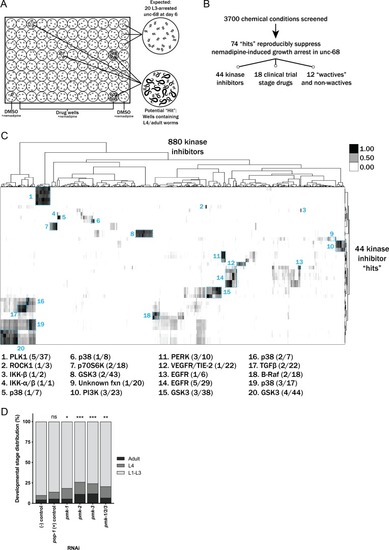Figure 2
- ID
- ZDB-FIG-200511-24
- Publication
- Volpatti et al., 2020 - Identification of drug modifiers for RYR1 related myopathy using a multi-species discovery pipeline
- Other Figures
-
- Figure 1
- Figure 2
- Figure 2-figure supplement 1
- Figure 2-figure supplement 2
- Figure 2-figure supplement 3
- Figure 2-figure supplement 4
- Figure 2-figure supplement 5
- Figure 3
- Figure 3-figure supplement 1
- Figure 4
- Figure 4-figure supplement 1
- Figure 4-figure supplement 2
- Figure 4-figure supplement 3
- Figure 5
- Figure 5-figure supplement 1
- Figure 5-figure supplement 2
- Figure 5-figure supplement 3
- Figure 5-figure supplement 4
- All Figure Page
- Back to All Figure Page
|
(A) Schematic of our screen methodology showing the expected growth arrest phenotype of unc-68 worms exposed to 25 ?M nemadipine after 6 days of exposure and the expected phenotype of a chemical that suppresses this growth arrest. (B) Summary of the 74 ?hits? from this screen that reproducibly suppressed nemadipine-induced growth arrest of unc-68 mutants. (C) Heat map visualization of Tanimoto scores from the ?hit? compounds (y-axis) screened from the 880 compounds in the GlaxoSmithKline Published Kinase Inhibitor set (x-axis). Tanimoto scores were calculated for each pair of compounds as a measure of structural similarity and similar clusters were identified via hierarchical clustering of Tanimoto scores (legend indicates the Tanimoto score). As shown, chemicals with similar molecular fingerprints are associated with similar annotated functions/targets. Fisher?s exact test was used to determine enrichment based on the number of structurally similar members in each cluster that were either hits or not hits out of the total number of the compounds in the library. (D) RNA interference targeting either pmk-1, pmk-2, pmk-3, or a combination of the three shows that p38 MAPK gene knockdown allows a greater proportion of individual unc-68 worms to escape nemadipine-A-induced growth arrest compared to an empty vector control. Statistical analysis by Kruskal-Wallis test, followed by Dunn's post-test; ns p=0.7360, *p=0.0246, **p=0.0031, ***p<0.001; left-right: n = 406, 364, 308, 292, 276, 266. |

